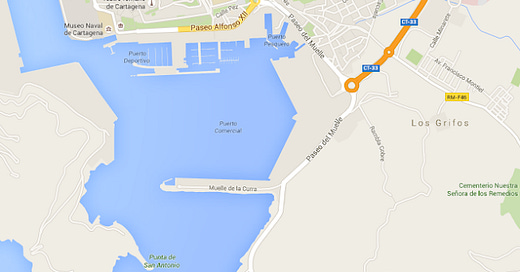Cartagena, Spain
Today is Cartagena, and there’s a good chance I'm not going to get off the boat. Not because there's anything wrong. Because I want to write.
Cartagena has a natural harbor, with a narrow entrance and a channel that makes several turns. Here’s a Google map of the entrance to the harbor. If I were working at a more responsive network I’d try to overlay this with an image of our ship so you can be amazed by the ship’s ability to navigate through the passage. For now you'll have to use a little imagination. But not too much.

Quantum is not a small ship; it’s a giant floating apartment house, 347m by 50m. Remember, 100m is about a football field. Despite its size it’s highly maneuverable, and it navigated through the channel without needing a tug for assistance and arrived just about on schedule. Yay captain Ban.
Quantum's main propulsion system is a pair of huge electric motors with power delivered, if I remember rightly, through slip joints, whatever they are. Whatever the mechanism, it lets the motors rotate through nearly 360 degrees, which makes it possible for them to pull the boat (normal configuration) or push it sideways. And of course it can pull the boat backward.
Quantum also has four bow thrusters, smaller electric motors, that give the captain greater ability to maneuver.
The narrow parts of the channel look to be around 250m wide on the map. The ship is 50m wide. That gives about 100m on each side, according to my calculations, but it sure seemed like less as I watched from decks 14 and 15.At the top of the map image you can see the wharf where quantum docked. To get there Quantum entered at Punta de San Antonio then had to swing its way past Muella de la Curia, then pivot to parallel the wharf. It’s a tricky ride.One of our waiters told me that when a ship like ours comes into harbor a harbor pilot comes out in a launch, goes to the bridge, and advises the ship’s crew rather than taking control. That makes sense since an error is likely to cause the ship more harm than the harbor. And because the propulsion and control systems of different ships must be quite different. (Side note: in the Suez Canal it appears that piloting is done by local personnel, who are trained using simulators, to use lots of different ship systems. But for them it's mostly a straight run. Not here.)Running bow thrusters and main engines at right angles to the boat, we heave up silt from the harbor bottom and push closer to the wharf. The ships throws out a blue line with a loop on the end. Someone on the wharf throws a grappling hook on an orange line, grabs the ship’s line and pulls it in. The ship feeds two giant hawsers attached to the ship's line. The men on shore float the hawsers to a bollard, the big iron posts to which the ship will be moored. They haul the hawsers up, one at a time and drop them over the bollard. Then winches on the ship go into action and tighten the hawsers and settle the ship against the wharf. The same thing happens at the other end of the ship.Everything goes smoothly. We're due in at 10:00 AM, and we're tied up and ready to debark at 10:15. Nice job, captain Ban.


